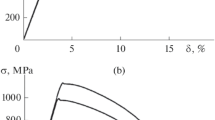Conclusions
-
1.
The effect of SA on steel 15Kh2NMFA is largest in the temperature range of 200–300o with aging for as long as 6 h.
-
2.
The nonmonotonic change in strength during SA with increasing preliminary deformation may be due to a difference in the extent to which dislocations are pinned by interstitial impurities.
-
3.
The change in the susceptibility of steel 15Kh2NMFA to embrittlement with increasing ε is due both to the dislocation-impurity interation (with small values of ε) and the interactions of dislocations (with large values of ε)
-
4.
An increase in the ductility of steel 15Kh2NMFA in the original (undeformed) condition leads to greater embrittlement during SA due to the increasing susceptibility of the steel to strain hardening.
Similar content being viewed by others
Literature Cited
V. K. Babich, Yu. P. Gul' and I. E. Dolzhenkov, Strain Aging of Steel [in Russian], Metallurgiya, Moscow (1972).
D. V. Wilson and B. Russel, “The contribution of atmosphere locking to strain aging of low-carbon steels,” Acta Med.,8, No. 1, 36–45 (1960); “The contribution of precipitation to strain aging of lowcarbon steel,” Acta Met.,8, No. 7, 468–479 (1960).
S. O. Suvorova, V. I. Sarrak, and R. I. Éntin, “Strain aging of commercial iron,” Fiz. Met. Metalloved.,17, No. 1, 105–111 (1964).
J. D. baird, “Strain aging of steel — a critical review,” Iron Steel,36, No. 5, 186–192 (1963).
A. A. Astaf'ev, V. N. Zenin, S. I. Markov, et al.: “Effect of strengthening and embrittlement on energy scattering during strain aging of steels for reactor shells,” Procbl. Prochn., No. 10, 94–102 (1977).
A. A. Astaf'ev, S. I. Arkhangel'skii, et al., “Effect of interactions of dislocations and interstitial impurities on strain aging of pearlitic housing steels,” in: Problems of Metal Science and Physics of Metals [in Russian], No. 5, Tula (1977), pp. 78–84.
Yu. P. Gul', “Effect of preliminary deformation on strengthening of commercial iron during natural aging.” Probl. Prochn., No. 5, 94–97 (1971).
A. V. Gur'ev and L. V. Kuksa, “Some characteristic features of strain on the yield plateau after strain aging of steel,” Fiz. Met. Metalloved.,16, No. 4, 589–595 (1963).
K. M. Pogodina-Alekseeva and E. E. Krotkova, “Effect of actual grain size on aging of structural steel MSt. 3,”, in: Heat Treatment and Strength of Metals and Alloys [in Russian], Moscow (1958), pp. 5–18.
W. Felix, Untersuchung der natürlichen und künstlichen Alterung von allgemeinen baustählen, Arch. Eisenhüttenw.,36, No. 1, 35–40 (1965).
Additional information
Central Scientific-Research Institute of Heavy Machine Construction. Translated from Problemy Prochnosti, No. 6, pp. 118–121, June, 1978.
Rights and permissions
About this article
Cite this article
Yukhanov, V.A. Effect of strain aging of the strength and toughness of pearlitic housing steel. Strength Mater 10, 732–735 (1978). https://doi.org/10.1007/BF01523915
Received:
Issue Date:
DOI: https://doi.org/10.1007/BF01523915




